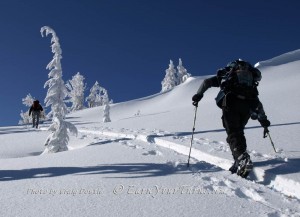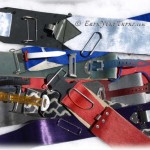Now that the Sun is heading for the horizon, and with it the excitement of getting out in the snow, thoughts that tend toward getting ready for those coming days lead to gear. One of the three basic BC essentials are climbing skins.
Experienced skinners know that good skins can make a difference in how many turns you earn. Not only in regard to how steep you can climb with them, but other things can add up, like glide on the upstroke, or across a meadow, and their tendency to ice-up when the icing is likely. If you’re new to this game of earning your turns, the most important thing is to simply get a pair of climbing skins. Used if that’s all the budget will allow because almost any climbing skin is vastly preferrable to none; except a pair that is failing.
Even in the case of skins that fail to impress, there are lessons to be learned that will help you in improving your technique that well intentioned advice from the voice of experience won’t teach the way stubbing your toe teaches you balance. The point being, if you’re new to BC skiing, don’t worry about getting the best skins, just get some. However, as with many things, proper preparation prevents piss poor performance. For those who are attuned to the subtler aspects of skinning, here is a brief primer on climbing skins for the coming (2014/15) season.
Grip
The whole purpose of climbing skins centers around grip; how much is enough and how does that balance with glide. Overall the difference in grip by the skin plush, and the limit of how steep you can go is largely determined by the fibers used. Nylon skins grip better, mohair skins glide better. However, with good technique, a less grippy mohair skin can hold well enough on anything other than a steep, polished skin track; the futility of expending that much energy to hold a steep line evades me. For reasonable and realistic tracks, their grip is essentially equal. For the few cases where it is not, technique can make up the difference.
Glide
Although technique can help with glide, this is another characteristic that is indigenous to the fibers in the plush. Mohair absolutely glides better, but still this is a subtle difference. One thing I have noticed — albiet after several years observation so this is but a bump in perception — blended weaves do not glide as well as either nylon or mohair. The exception is Pomoca’s lowest cost nylon skins, the green weave that K2 has used the past few years, is the slowest, least gliding skin I’ve experienced. Blends are just a notch below a good nylon available from any number of brands — Ascension, G3, Pomoca, Colltex — and definitely less than mohair. Having good glide requires less energy to slide your ski forward with each step. It is a minor value, maybe adding 2% to the more dominant effect of raising the weight of your skis, boots, and bindings, but it is energy that adds up after 20,000 steps. That’s why rando racers use mohair because every ounce of saved energy can be reinvested in going faster. To the rest of us, we notice it more when crossing meadows, or straight lining a short downhill pitch.
It’s about the glue
The most practical consideration with climbing skins these days has little to do with their on-snow performance and everything to do with simply putting them on and taking them off. In other words, the glue. In the new millenium the problems of glue not holding a skin to a ski reliably are ancient history. All the glues these days do a bang up job of holding the skin to the ski, at least, out of the box.
Two issues become apparent. Over time the glue changes and either gets stickier, or loses the ability to adhere. Secondly, in daily use the tackiness of the glue may be too much, requiring a lot of muscle and a fair bit of technique to pull them apart after storing glue-to-glue. This problem is more apparent the wider the skins are. Duh.
Until recently, the solution was to provide silly skin saver sheets, coarse plastic screens that you stick to the bottom of the skins for storage. A royal pain in the ass to deal with on a windy ridge and just one more stupid piece of gear I’d rather not deal with. While it is true you can overcome the excess stickiness of pulling skins apart with some learned techniques but there is another fatal flaw with skins that rely solely on tackiness for adhesion. If you get them dirty, they lose their grip. Sometimes selective contamination makes these glues easier to manage. Dropping them in the dirt usually results in catastrophic failure and a laborious re-gluing exercise, or more likely, replacement.
“Glueless” glue
A new solution is the development of silicone based glues that rely on suction to provide adhesion to your skis. Most companies are marketing skins with this formula as “glueless” climbing skins. “Glueless” means deceptive marketing spin. I liken it to a Post-It, where the glue is just strong enough to hold on when pressed flat, but comes off easy when you peel it. By comparison, classic skin glue is like warm Duct Tape. Effective, but messy and unforgiving.
Colltex worked on a formulation for this years ago, but it didn’t catch fire because you absolutely could not store the skins glue-to-glue. The requirement for a special skin saver sleeve made them impractical. Gecko came out with a decent silicone-based formula, but when it got old it left a residue and started falling off in little balls, or in some cases, came off in sheets. Out of the box though, Geckos were an absolute delight to deal with. Easy on, easy off. If you dropped them in the dirt, just brush the dirt off. In worst case scenarios you can scrub the dirt off under running water. And Gecko’s are mohair, so they have great glide.
Two companies are introducing glueless skins to the US market in 2015, High Trails and Volkl. Both of them offer the easy management of Post-It like silicone glue and an unproven track record. High Trails is offering a lifetime warranty on the glue. That’s a bold statement, but in the worst case scenario should keep you with a working pair of skins for at least five years, at which time either they will either be bankrupt from the cost of so many returns, or they’ll be riding high because the glue will have proven itself and if these silicone-based glues can go the distance, nobody in their right mind would buy the overly sticky skins except to save a buck. Considering these new “glueless” skins are all priced around $250 per pair, $100 may be an acceptable price to pay for dealing with overly sticky skins.
Tip and Tail Kits
This is a subject that is dealt with in great detail elsewhere on this site. You want a good tip and tail kit, with some elasticity between the two to take up the slack in your skins when they stretch because they will when they inevitably get wet. Either the stretch is in the tip, or the tail. Which one you prefer depends on how limber your hips and knees are. If you rip the hide at the top without taking skis off, do you prefer to rip from the tip or tail? If you rip from the tail, you better be limber and get a stretchy tail system. My recommendation is the Ascension STS tail with a cammed hook. It can be substituted on any climbing skin. For those who prefer to rip from the tip, get a system with a bungeed tip loop. Details on most systems here.
Bottom Line
If you’re new to backcountry skiing, pretty much any ol’ pair of climbing skins will do. If you’re looking for a replacement pair, or to outfit a new rig, my recommendation is to go for the new Post-It style climbing skins. You may wince at the cost, but will be happier down the road. Or save $100 and stick with the glue you know, even if you need a crowbar to pry ’em off . 😉
© 2014
Related Posts:
Skin Glue Confessions (2013)
Tip and Tail kits for Climbing Skins




Recent Comments